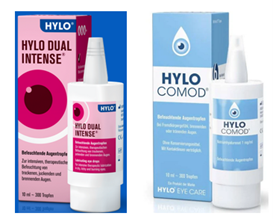Difference is crucial – HYLO
The case: It is well known that difference is crucial in distinguishing new trade marks from prior ones. In practice, however, this self-evident rule repeatedly gives rise to issues:
A German pharmaceutical company markets drops for treating dry eyes. The drops contain the active ingredient ‘sodium hyaluronate’, known in Germany as
![]()
[hyaluronic acid].
The company has registered the word mark![]()
It has developed an entire range of eye drops with this brand name, such as:

An Italian pharmaceutical company also sells drops for dry eyes in Germany, which also contain the active ingredient hyaluronic acid. The company has registered the trade mark
![]()
The German manufacturer saw this as an infringement of its ‘HYLO’ trade mark and sued the Italian company for injunctive relief and damages. It claimed that ‘HYALU’ did not maintain the necessary difference from ‘HYLO’ and therefore could easily be confused with its own product. ‘HYLO’ does not have a small scope of protection. It is a specially developed artificial word and contains no descriptive allusion to the active ingredient hyaluronic acid. With a market share of over 30%, the company is the market leader.
But could the signs really be confused?
In Germany, ‘hyaluronic acid’ is well known, being commonly highlighted in advertising and on product packaging as the active ingredient in eye drops . The German consumer is therefore also aware that ‘HYLO’ is just a variation of ‘hyaluronic acid’. In fact, ‘HYLO’ takes the first syllable ‘Hy’ from the well-known name of the active ingredient, which also initiates the comprehension of the trademark. In addition, the phonetically important letters ‘l’ and ‘o’ are taken from ‘hyaluronic acid’.
What is original about ‘HYLO’ is the unusual combination or partial omission of letters that gives ‘HYLO’ its distinctive character. This element provides the public with an indication of the origin of the eye drops as being from the German company.
‘HYALU’ also contains a variation of the name of the active ingredient. However, unlike ‘HYLO’, ‘HYALU’ retains the beginning of ‘hyaluronic acid’. In particular, ‘HYALU’ does not contain the distinctive contraction of the letters that ‘HYLO’ does.
But was that difference at all relevant to the similarity of the marks?
The answer is yes. Both signs contain different variations of the same descriptive term.
The visual effect of the modifications is therefore different. And ‘HYLO’ sounds different from ‘HYALU’. It is unlikely that the public would perceive the designations side by side, and so any similarity between the marks must arise from the public’s memory. However, as the public are particularly attentive when buying eye drops and other items relating to medical treatment, including the purchase of medicines and medicinal products, they will remember the visual and phonetic differences between the variants.
The similarities are essentially confined conceptually to the non-proprietary term. However, the public are aware, because of the increased attention paid towards medical products, that the names of medicines or medicinal devices often contain syllable-by-syllable variations of the names of the active ingredients. The public therefore would not infer, from such references to active ingredients, that the products come from a particular undertaking and would not consider the marks to be conceptually similar because of the similarity of such references to active ingredients.
Trade marks that are recognisably based on a descriptive indication, such as ‘HYLO’, inherently have a limited scope of protection. However, even if the scope of protection of ‘HYLO’ were to be extended on the basis of its market leadership, this means nothing more than that its small scope of protection is increased to a normal scope of protection, and this would not be sufficient to compensate for the lack of similarity between the marks.
Contrary to the lower court’s assessment, ‘HYALU’ was sufficiently different from ‘HYLO’ and could not be confused with it. The infringement claim was dismissed on appeal,
Munich Higher Regional Court, 05.08.2020, case 29 U 4547/19.
Learnings: If there are already marks based on the same descriptive non-proprietary term as your intended future mark, you should ensure there is a clear difference between your mark and existing modifications of the term used on other products. To do this, you need to analyse the structure of the existing variations of the descriptive term and choose a different affiliation structure for your new mark. Please note, however, that trade marks based on descriptive terms have a limited scope of protection, and this will also make your new mark less defensible!
Note: Please also read the following BestCase on the scope of protection of trade marks with descriptive elements: